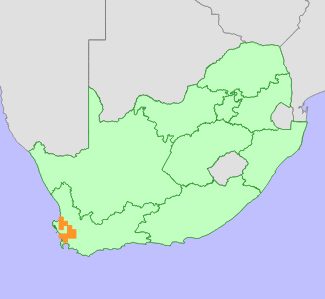|
Scientific Name | Leucadendron stellare (Sims) Sweet |
Higher Classification | Dicotyledons |
Family | PROTEACEAE |
Synonyms | Leucadendron empetrifolium Gand., Leucadendron imbricatum R.Br., Leucadendron polygaloides Link |
Common Names | Star Conebush (e) |
National Status |
Status and Criteria | Endangered A2c |
Assessment Date | 2018/11/01 |
Assessor(s) | A.G. Rebelo, H. Mtshali & L. von Staden |
Justification | Leucadendron stellare is endemic to lowland areas of the Western Cape Province. It has an extent of occurrence (EOO) of 4823-5519 km² and an area of occupancy (AOO) of 432-456 km². A population reduction of 50-70% is inferred from the extent of habitat loss over the past three generations (300 years). It therefore meets the thresholds for Endangered under criterion A. |
Distribution |
Endemism | South African endemic |
Provincial distribution | Western Cape |
Range | This species is endemic to the coastal lowlands of the Western Cape in South Africa, where it occurs from Aurora to Cape Flats. |
Habitat and Ecology |
Major system | Terrestrial |
Major habitats | Saldanha Flats Strandveld, Swartland Shale Renosterveld, Swartland Alluvium Renosterveld, Cape Flats Sand Fynbos, Atlantis Sand Fynbos, Hopefield Sand Fynbos, Leipoldtville Sand Fynbos, Swartland Alluvium Fynbos |
Description | It occurs in level, dry sands over clay, 20-200 m. It is a long-lived species, and survives fires by resprouting from underground boles or rootstocks, thus generation length exceeds 100 years. Wind-dispersed seeds are released after ripening, and are stored in surface leaf-litter. It is dioecious, with insect-pollinated male and female flowers occurring on separate plants. |
Threats |
| Agricultural expansion (predominantly cereal and wheat cultivation) has caused extensive loss and fragmentation of this species' habitat. Isolated remnants continue to be degraded due to overgrazing, alien invasive plants and inappropriate fire management. |
Population |
Land cover data indicates that 73% of this species' habitat has been lost. This species is a long-lived resprouter (generation length >50 years), and based on the extent of habitat loss, a population reduction of 50-70% over three generations is inferred.
Most remaining subpopulations are small and confined to isolated remnants, with 23% containing fewer than 10 plants. Larger remaining subpopulations in the northern section of the range are declining due to ongoing habitat loss to potato cultivation. A large subpopulation of more than 10 000 plants remains in three adjacent protected areas on the eastern side of its range.
|
Population trend | Decreasing |
Assessment History |
Taxon assessed |
Status and Criteria |
Citation/Red List version | | Leucadendron stellare (Sims) Sweet | EN A2c | 2020.1 | | Leucadendron stellare (Sims) Sweet | CR A2c | Raimondo et al. (2009) | | Leucadendron stellare (Sims) Sweet | Not Threatened | Hilton-Taylor (1996) | | Leucadendron stellare (Sims) Sweet | Indeterminate | Hall et al. (1980) | |
Bibliography |
Goldblatt, P. and Manning, J.C. 2000. Cape Plants: A conspectus of the Cape Flora of South Africa. Strelitzia 9. National Botanical Institute, Cape Town.
Hall, A.V., De Winter, M., De Winter, B. and Van Oosterhout, S.A.M. 1980. Threatened plants of southern Africa. South African National Scienctific Programmes Report 45. CSIR, Pretoria.
Hilton-Taylor, C. 1996. Red data list of southern African plants. Strelitzia 4. South African National Botanical Institute, Pretoria.
Manning, J.C. and Goldblatt, P. 2012. Plants of the Greater Cape Floristic Region 1: The Core Cape Flora. Strelitzia 29. South African National Biodiversity Institute, Pretoria.
Raimondo, D., von Staden, L., Foden, W., Victor, J.E., Helme, N.A., Turner, R.C., Kamundi, D.A. and Manyama, P.A. 2009. Red List of South African Plants. Strelitzia 25. South African National Biodiversity Institute, Pretoria.
Rebelo, T. 2001. Sasol Proteas: A field guide to the proteas of southern Africa. (2nd ed.). Fernwood Press, Vlaeberg, Cape Town.
|
Citation |
| Rebelo, A.G., Mtshali, H. & von Staden, L. 2018. Leucadendron stellare (Sims) Sweet. National Assessment: Red List of South African Plants version . Accessed on 2025/06/28 |
 Comment on this assessment
Comment on this assessment

